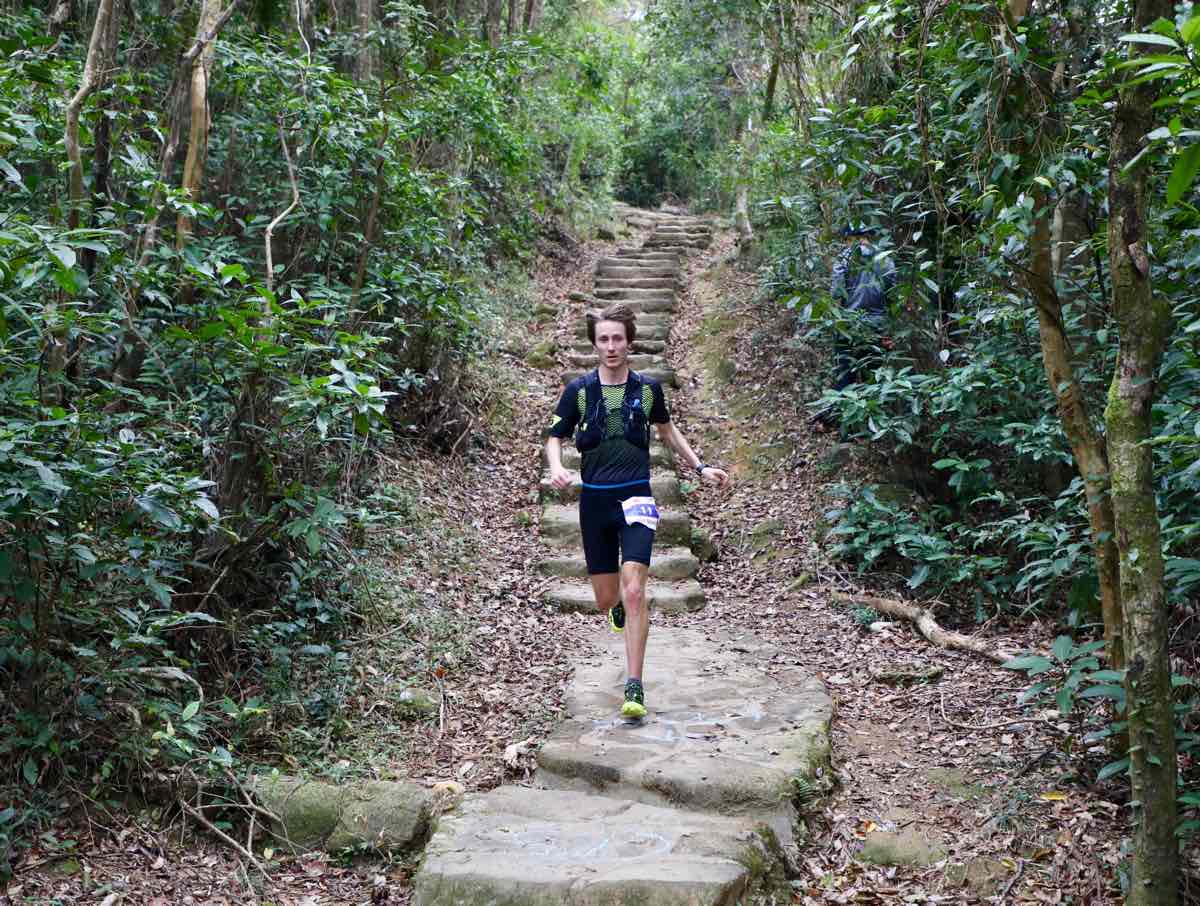[Editor’s Note: Today we are so excited to welcome trail runner, ultrarunner, and coach Alex Nichols to iRunFar’s contributor team! His column ‘Always Improving’ is our brand-new coaching column and will publish monthly. Welcome, Alex!]
It was sticky humid. Sweat was stinging my eyes and dripping off my chin. Just a few days before I had been training in below-freezing temperatures in the dry air of Colorado. Suddenly I was thrown into the mountains of Hong Kong, attempting to run 100 kilometers as fast as I could. I hit a climb at the 48-kilometer mark that looked like it went on forever, all hard-packed clay and stone stairs–so many stairs. I started walking for the first time in the race. I felt like I couldn’t go any slower. At any moment, I would probably be passed by hundreds of runners.
The 2018 Vibram Hong Kong 100k started well. I had cruised through the early portion of the race, feeling comfortable and holding a top-15 spot. We were running fast in those early miles, including a few six-minute miles mixed in, but I felt like I was holding back. I could hear the runners next to me breathing hard trying to hold pace, and I smugly thought to myself that they would drop off soon. The course is notoriously difficult later on, with almost all of the elevation coming in the second half. It was all going to plan until we hit some climbs and descents that I didn’t remember seeing on the course profile. Those little blips on paper were quad-thrashing mountains in person. I was holding my position, but my breathing wasn’t so easy anymore. I grew less smug and more worried.
In the course of a few slow kilometers, my entire mood changed. I went from being excited and focused, to feeling absolute dread. I was afraid of being caught by the other runners. I questioned my abilities. I was thinking, Why am I out here doing this to myself? I don’t belong here. I’m probably not going to finish. I even remember coming into the 50k aid station yelling to my wife Maddy who was crewing me, “This is the hardest race in the world!” My inner dialogue was entirely negative and my confidence gone at that point, but I at least got myself out of the aid station and back onto the course.
Once I was back in the race, I hit a steady downhill and started to move faster again. In that moment I decided that I had come too far and worked too hard to let myself fall into a hole of negativity. It was a surprising moment of clarity that came to me during that dark time. I started repeating two phrases to myself: “I’ve come this far. Just keep pushing.” Those spur-of-the-moment mantras pushed me throughout the rest of the race.
All athletes deal with self-talk. It just so happens that distance runners, especially ultramarathoners, have a lot of extra time to grapple with their inner dialogue. These thoughts can be productive and boost confidence, or they can be destructive, with the ability to ruin a race. Ellis (2) describes the ABC’s of self-talk as A: the activating event, B: the beliefs or interpretation of the situation, and C: the consequences of how we handled the activating event. In my case, the activating event was the climb at the 48-kilometer point. It was that dismal moment that activated my negative self-talk. I initially interpreted the event as the end of my competitive race. As I stared up at the impossible climb in front of me, I was very ready to call the whole thing off and go back to the U.S. on the next flight. However, after the 50k aid station, I reframed my beliefs about the situation when I began to use my mantra “I’ve come this far. Just keep pushing.” The consequence of my belief was that I improved my emotional state and increased my motivation and confidence, which in turn led to a better performance in the race.
Just like planning a race strategy, you can plan to overcome negative self-talk by developing a positive mantra. It is not a matter of if negative thoughts will occur, but when. Positive mantras can be developed for a specific race, but also for use in training and pre-race situations. Burton and Raedeke (1) recommend keeping these aspects of positive self-talk in mind when developing your self-talk script or mantra:
Be an optimist. Focus on what you can do, not what you can’t. For example, consider using a phrase like “Keep moving up.” instead of “Don’t let people pass me.” Only use positive affirmations in your mantra.
Be specific and focus on the present. Align your mantra with your pre-race goals. What can you do to make this race the best it can be? You can consider the conditions, the distance, and even the surface. Let’s say you are about to race a hot year at the Western States 100. A specific mantra for those conditions could be, “Cool and easy.”
Be realistic. Focus on things that are within your control, such as your own race instead of what happens to others. You can’t control what happens around you, but you can be ready when changes occur. You could even develop a mantra to be ready if you happened to get off-course. It might not happen often, but you can prepare for the unexpected with a mantra like, “I can adapt to anything.”
Make it something short and use it often. The best mantras are ones that are easy to remember and repeat. You have enough to focus on during a race, so make your mantra something that is easy to recall and use. Eight words or less is ideal.
Once you have started to develop your personal mantras, write them down and save them. Creating a collection of mantras on notecards is a great way to have your mantras on hand. These can be just the confidence boost you need before going into a tough workout or intimidating race. With a little planning you can be prepared to change your beliefs the next time you are faced with an activating event.
Out there on the stony trails of Hong Kong, I was lucky enough to develop my mantras out of pure desperation. Those phrases were my way of disrupting my negative beliefs by reminding myself of the training it took to get to this point and the distance I had already covered. It reassured me that I had the ability to finish the race if I just kept moving forward. As I repeated those mantras I moved up through the field, all the way to second place. Successfully confronting my negative thoughts with very little pre-race planning was a stroke of luck, and something I would not recommend relying on. By coming into the situation more prepared than I was, you can determine the physical and emotional consequences of your internal dialogue.
Call for Comments (from Meghan)
- Have you ever intentionally or unintentionally used mantras to help you during a race or difficult training run?
- What mantras have you used? How and why did you choose them?
References
- Burton, D., & Raedeke, T. D. (2008). Sport psychology for coaches. Leeds: Human Kinetics.
- Ellis, A. (2014). Better, deeper, and more enduring brief therapy: the rational emotive behavior therapy approach. New York, NY: Routledge.


